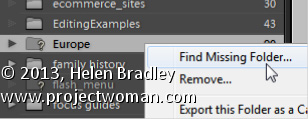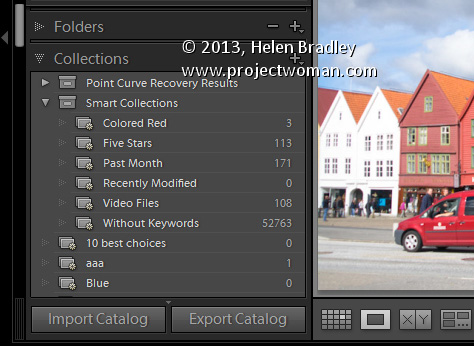Sunday, June 16th, 2013

How to solve the problem of Lightroom reporting a folder as missing
If a folder is missing, it will have a question mark beside its name in the Lightroom library.
You can sort out Lightroom’s problem by locating the missing folder – to do this, right click the folder name in Lightroom and choose Find Missing Folder.
Now navigate on your disk to find the folder that Lightroom can’t find. When you have done this all the contents from that folder will be added back into the Lightroom catalog automatically.
The reason that Lightroom can’t find your folder is because you have done something to it outside Lightroom. In future, move and rename folders from inside Lightroom and this problem won’t occur.
Helen Bradley
Labels: ?, Find, Find Missing Folder, folder, Library, library module, Lightroom, locate, missing, missing folder, question mark
Categories:Lightroom, photoshop
posted by Helen Bradley @ 8:27 amNo Comments links to this post
Thursday, May 23rd, 2013

Understanding why you should use Collections in Lightroom
A Lightroom collection is different to a folder. A folder contains images but a Collection contains only pointers to those images, which exist somewhere on your disk. In Lightroom each image exists in just one folder but it might be in many different collections.
For this reason collections are a great way to organize your photos. For example, you can use collections to assemble images for printing or for creating a slideshow.
You can add images to a collection from one or many folders. So, collections are a great way to create a central location where you can view and work with a set of images that may be located in multiple folders on your disk. Because collections are merely pointers to your images they take up very little disk space.
Helen Bradley
Labels: collection, collections panel, folder, image, Library, library module, Lightroom, organize, slideshow, what are collections, working with collections
Categories:Lightroom, photoshop
posted by Helen Bradley @ 8:39 amNo Comments links to this post
Thursday, January 10th, 2013
 Photo Credit: Kriss Szkurlatowski
Photo Credit: Kriss Szkurlatowski
Creating multiple new folders in windows can be a pain, since it forces you to click through multiple context windows every time. It can, however, be bypassed with a nifty set of keyboard commands that navigate those windows for you.
While in the Windows Explorer view, simply hold Alt and press F+W+F. This opens the File menu, selects New, and chooses Folder almost instantly. This is extremely useful because it allows you to create and rename multiple new folders without taking your hands off of the keyboard.
You can use these commands to open other menus as well. While holding Alt you will notice certain letters of menu selections become underlined. Pressing these letters on your keyboard will select that menu option. For example, Holding Alt and pressing F+W+S will create a new shortcut. This functionality extends to Microsoft Office as well. The next time you’re in Word, press Alt and see what you can start controlling with a few key strokes.
Helen Bradley
Labels: explorer, folder, keyboard, Microsoft, new, Office, shortcut, windows
Categories:hunter, office
posted by Hunter Delattre @ 9:00 amNo Comments links to this post




